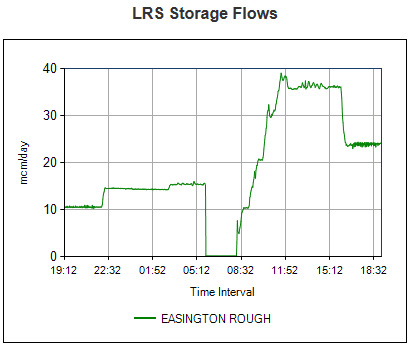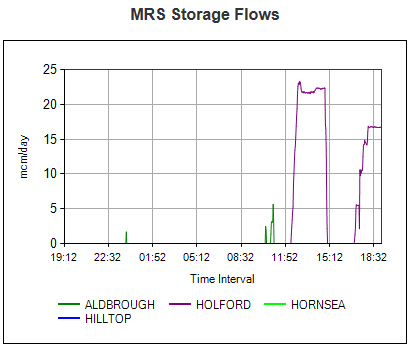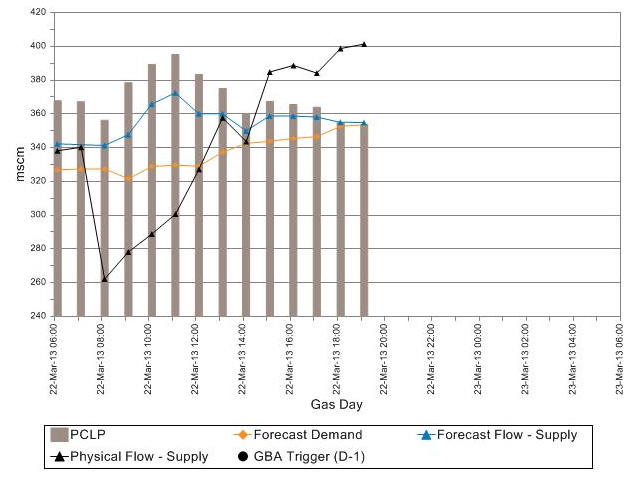Earlier today I wrote about an outage at the Bacton Interconnector, which imports gas from Belgium to the UK. The outage was caused by the failure of a simple pump, but couldn't have come at a worse time, given the low amount of gas in UK storage and the ongoing cold weather. So how did the UK and National Grid cope with the outage, and what are the consequences? The following graphs were all screen captured from National Grid's Instantaneous Flows Report in 24-hour view at about 7:30pm on Fri 22 March 2013.
This first one shows the problem - the blue line represents gas entering the UK via the Bacton Interconnector. From about 7am to 2pm there was little or no gas coming through, compared to the rest of the day when the flow was about 70mcm/day. So that's about 20mcm that had to be found from other places to meet today's UK gas demand (which is high, due to the cold weather). Demand today was around 350mcm, so this was just under 6% of the day's demand that went missing.
Well, clearly the lights didn't go our (remember that about a third of our electricity is generated by burning gas), so what happened? Well, the first thing was that gas started flowing out of Long Range Storage, which is actually an old gas field called Rough. There was no gas coming out of this prior to the Bacton outage, but about an hour after it, flows started and ramped up close to maximum for the duration of the outage, and stayed a bit above half maximum afterwards. To put this in context, if gas was drawn from LRS at maximum rate continuously, we only have enough in it right now to keep going for about 5 days.
A little bit later on, extra gas started flowing from one of the Liquefied Natural Gas (LNG) terminals. This is gas that arrives on tankers from Qatar and other places, is pumped into storage vessels and released gradually as required. However, we've not been able to import much LNG in the past year, as Japan is buying a lot of the global supply, to replace the output of the nuclear power stations that were shut down after Fukushima. There's about 65% more gas in the LNG stores than there is in LRS right now. At the time of writing the flows coming out of LNG were about 18mcm/day, at which rate the stocks would last about 21 days - but with more cold weather coming, the withdrawal rate could increase.
As the outage continued, gas also started flowing from the Medium Range Stores. There's currently about the same amount of gas in MRS as in LRS, but it can be released faster when required - though clearly that would only then give us a few days' supply.
This final graph was from one of the links on National Grid's Prevailing View page. The black line indicates actual flows, and the orange line indicates the estimate for the day's gas demand at that point in the day. The effect of the Bacton outage is clear, as is the increased supply post-outage to compensate for what went missing.
So the good news is that the 'market' worked, and enough gas arrived despite the outage. The bad news is that the extra supply came out of storage and LNG, reducing stocks. This is a problem because the coming week is forecast to be unseasonably cold for March - check out the 'feels like' temperature map at the Met Office. Add to this the fact that one large coal power station shut for good today (Didcot A, 2,000 MW), and others are to follow - so that means more gas being burned to generate electricity.
So, we have a tight week ahead for gas and electricity supply in the UK, with the cold weather. What about after that? I'm sure we're all hoping Spring will arrive eventually, and be followed by a decent summer. But even if everywhere is lovely and warm, there's still a job to be done - refilling the gas storage and getting the LNG stores back up to a decent level. This will be expensive work - we need to import a lot of gas to do this, and ultimately it's you and I who are going to pay for it, one way or another. But it's not even that simple sadly... Norway needs to take about 40 mcm/day of production offline from 1 April to 2 August to carry out maintenance. This is bound to reduce availability to some extent in the European gas market, so can only push prices higher, and perhaps even limit what it is possible for us to put back into the gas stores before next winter.
Let's hope the summer is a warm one...





And make next winter a warm one too!
ReplyDeleteOne thing that has helped today, the UK's wind fleet has been pumping out over 5GW all day, that was 11% of our electricity supply when I checked this afternoon, and 15% now. That's got to be a record.
The gas power stations have been ramped down accordingly. Without the wind today we would drawn on even more storage.
Interesting point - it was the wind that boosted the windchill and hence the need for heating, but it also boosted generation. Hopefully the same will be true in the coming few days as well.
Delete